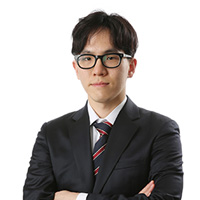MMCA sheds new light on late Korean artist Quac In-sik
By Shim Woo-hyunPublished : June 12, 2019 - 17:43
Fractured pieces of a glass pane are put together in artist Quac In-sik’s works. The broken glass bears impressions of the heavy metal ball that fell on it, dramatically revealing the materiality of the fragile object.

Quac’s experimental works have greatly influenced many artists who came after him, but his works have been unheralded.
The National Museum of Modern and Contemporary Art’s Gwacheon branch is holding a Quac retrospective, part of its attempt to reassess the artist’s influence on the South Korean and Japanese art scenes.
“Quac In-sik has been known for his painting series using traditional ink. But this exhibition focuses more on his works made with glass, which present his great interest in materials and their materiality,” exhibition curator Park Soo-jin said during a press conference held Wednesday at the MMCA’s Gwacheon branch.
The exhibition, which celebrates the 100th anniversary of Quac’s birth, features some 100 works in addition to 100 archival materials from Korea and Japan.

Born in Daegu in 1919, Quac lived most of his life in Japan after moving there in 1937 to study at the Japan Fine Art School.
He returned to Korea in 1942 to hold an exhibition in Daegu but went back to Japan in 1949 to focus on his productions. In 1985, he returned for a retrospective exhibition at the MMCA. He died of cancer in 1988.
Quac chose to stay in Japan, even though he did not receive much attention from critics or the public at the time, because it was the only place he could create avant-garde art by then, curator Park explained.
In Japan, Quac produced a wide range of works, from paintings to experimental works that utilized various materials, including glass, brass and paper, and held more than 50 exhibitions.
The MMCA said Quac greatly influenced the pioneering art movement Mono-ha (School of Things), which came to being in Tokyo in the late 1960s, led by the Korean artist Lee U-fan and Nobuo Sekine.
A video of interviews of Japanese art critics and Korean artists shown at the exhibition says Quac and Lee U-fan share a certain aesthetic, even though the two artists are quite different from each other.

It was after an exhibition in Tokyo in 1975 that Quac began receiving a significant reception in Japanese art circles, through art critics Joseph Love and Minemura Toshiaki.
However, interest in the artist soon faded and Quac remained neglected both in Japan and Korea, according to the museum.
According to the MMCA, this may have been largely due to the artist’s background. Quac was a Korean artist living and working in Japan and thus had loose connections to both the Korean and Japanese art scenes.
Hyundai Gallery in 1982 held a retrospective exhibition for Quac, highlighting only part of the artist’s oeuvre. The MMCA’s 1985 retrospective was larger in scale, but ran it for only 10 days.
The latest exhibition at the MMCA’s Gwacheon branch aims to do what should have been done earlier -- give Quac his due as an artist whose work merits a serious look.
The exhibition is divided into three sections, organized chronologically.
The first section includes his early period from 1937 to the end of the 1950s. Titled “Perception of Reality and Exploration,” the section includes his 1937 painting “Figure(man),” which is thought to be a self-portrait. Quac’s surrealist painting also shows his keen interest in the international art trends of his time.

The highlight of the exhibition is a section titled “Fractures and Sealing (1960s to 1975),” which presents a range of works that demonstrate the artist’s experimentation with various objects, including glass and brass.
The last section includes installations of stones, earthenware and wood, in addition to his well-known color-dot paintings.
The exhibition runs through Sept. 15 at MMCA Gwacheon.
By Shim Woo-hyun (ws@heraldcorp.com)


















